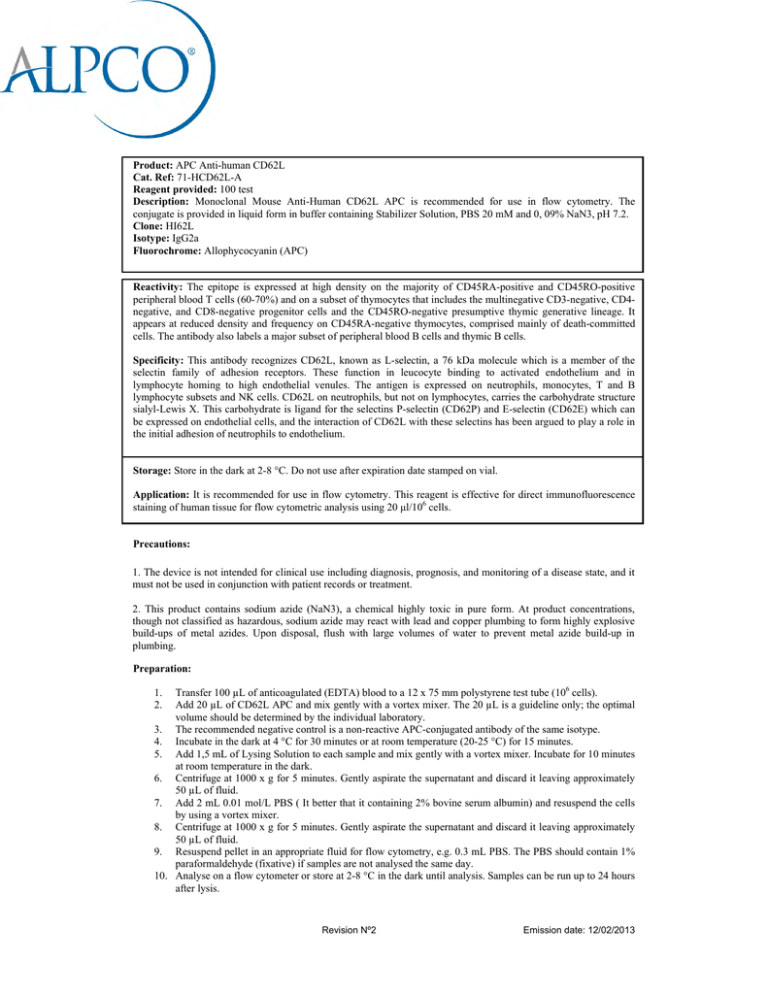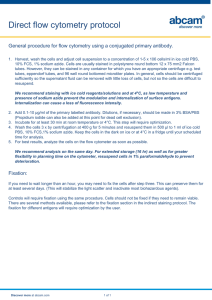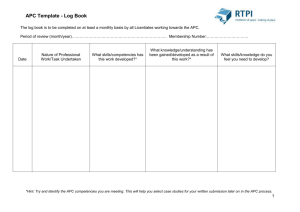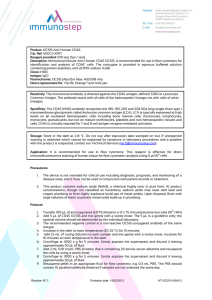Product: APC Anti-human CD62L Cat. Ref: 71-HCD62L
advertisement

Product: APC Anti-human CD62L Cat. Ref: 71-HCD62L-A Reagent provided: 100 test Description: Monoclonal Mouse Anti-Human CD62L APC is recommended for use in flow cytometry. The conjugate is provided in liquid form in buffer containing Stabilizer Solution, PBS 20 mM and 0, 09% NaN3, pH 7.2. Clone: HI62L Isotype: IgG2a Fluorochrome: Allophycocyanin (APC) Reactivity: The epitope is expressed at high density on the majority of CD45RA-positive and CD45RO-positive peripheral blood T cells (60-70%) and on a subset of thymocytes that includes the multinegative CD3-negative, CD4negative, and CD8-negative progenitor cells and the CD45RO-negative presumptive thymic generative lineage. It appears at reduced density and frequency on CD45RA-negative thymocytes, comprised mainly of death-committed cells. The antibody also labels a major subset of peripheral blood B cells and thymic B cells. Specificity: This antibody recognizes CD62L, known as L-selectin, a 76 kDa molecule which is a member of the selectin family of adhesion receptors. These function in leucocyte binding to activated endothelium and in lymphocyte homing to high endothelial venules. The antigen is expressed on neutrophils, monocytes, T and B lymphocyte subsets and NK cells. CD62L on neutrophils, but not on lymphocytes, carries the carbohydrate structure sialyl-Lewis X. This carbohydrate is ligand for the selectins P-selectin (CD62P) and E-selectin (CD62E) which can be expressed on endothelial cells, and the interaction of CD62L with these selectins has been argued to play a role in the initial adhesion of neutrophils to endothelium. Storage: Store in the dark at 2-8 °C. Do not use after expiration date stamped on vial. Application: It is recommended for use in flow cytometry. This reagent is effective for direct immunofluorescence staining of human tissue for flow cytometric analysis using 20 μl/106 cells. Precautions: 1. The device is not intended for clinical use including diagnosis, prognosis, and monitoring of a disease state, and it must not be used in conjunction with patient records or treatment. 2. This product contains sodium azide (NaN3), a chemical highly toxic in pure form. At product concentrations, though not classified as hazardous, sodium azide may react with lead and copper plumbing to form highly explosive build-ups of metal azides. Upon disposal, flush with large volumes of water to prevent metal azide build-up in plumbing. Preparation: Transfer 100 µL of anticoagulated (EDTA) blood to a 12 x 75 mm polystyrene test tube (106 cells). Add 20 µL of CD62L APC and mix gently with a vortex mixer. The 20 µL is a guideline only; the optimal volume should be determined by the individual laboratory. 3. The recommended negative control is a non-reactive APC-conjugated antibody of the same isotype. 4. Incubate in the dark at 4 °C for 30 minutes or at room temperature (20-25 °C) for 15 minutes. 5. Add 1,5 mL of Lysing Solution to each sample and mix gently with a vortex mixer. Incubate for 10 minutes at room temperature in the dark. 6. Centrifuge at 1000 x g for 5 minutes. Gently aspirate the supernatant and discard it leaving approximately 50 µL of fluid. 7. Add 2 mL 0.01 mol/L PBS ( It better that it containing 2% bovine serum albumin) and resuspend the cells by using a vortex mixer. 8. Centrifuge at 1000 x g for 5 minutes. Gently aspirate the supernatant and discard it leaving approximately 50 µL of fluid. 9. Resuspend pellet in an appropriate fluid for flow cytometry, e.g. 0.3 mL PBS. The PBS should contain 1% paraformaldehyde (fixative) if samples are not analysed the same day. 10. Analyse on a flow cytometer or store at 2-8 °C in the dark until analysis. Samples can be run up to 24 hours after lysis. 1. 2. Revision Nº2 Emission date: 12/02/2013 References: 1. 2. 3. 4. Kleinclauss F, Perruche S, Masson E, de Carvalho Bittencourt M, Biichle S, Remy-Martin JP, Ferrand C, Martin M, Bittard H, Chalopin JM, Seilles E, Tiberghien P, Saas P. Intravenous apoptotic spleen cell infusion induces a TGF-beta-dependent regulatory T-cell expansion. Cell Death Differ. 2005 Jun 17 Eberl M, Engel R, Aberle S, Fisch P, Jomaa H, Pircher H. Human Vgamma9/Vdelta2 effector memory T cells express the killer cell lectin-like receptor G1 (KLRG1). J Leukoc Biol. 2005 Jan;77(1):67-70. Lima M, Almeida J, Dos Anjos Teixeira M, Alguero Md Mdel C, Santos AH, Balanzategui A, Queiros ML, Barcena P, Izarra A, Fonseca S, Bueno C, Justica B, Gonzalez M, San Miguel JF, Orfao A. TCRalphabeta+/CD4+ large granular lymphocytosis: a new clonal T-cell lymphoproliferative disorder. Am J Pathol. 2003 Aug;163(2):763-71. Maugeri N, de Gaetano G, Barbanti M, Donati MB, Cerletti C. Prevention of platelet-polymorphonuclear leukocyte interactions: new clues to the antithrombotic properties of parnaparin, a low molecular weight heparin. Haematologica. 2005 Jun;90(6):833-9. *Note: For research use only. Not for diagnostic use.. Revision Nº2 Emission date: 12/02/2013



![Anti-CD62L antibody [B-S13] ab47078 Product datasheet 1 Image Overview](http://s2.studylib.net/store/data/012450049_1-d7945442e168432fe695f9986691019b-300x300.png)
